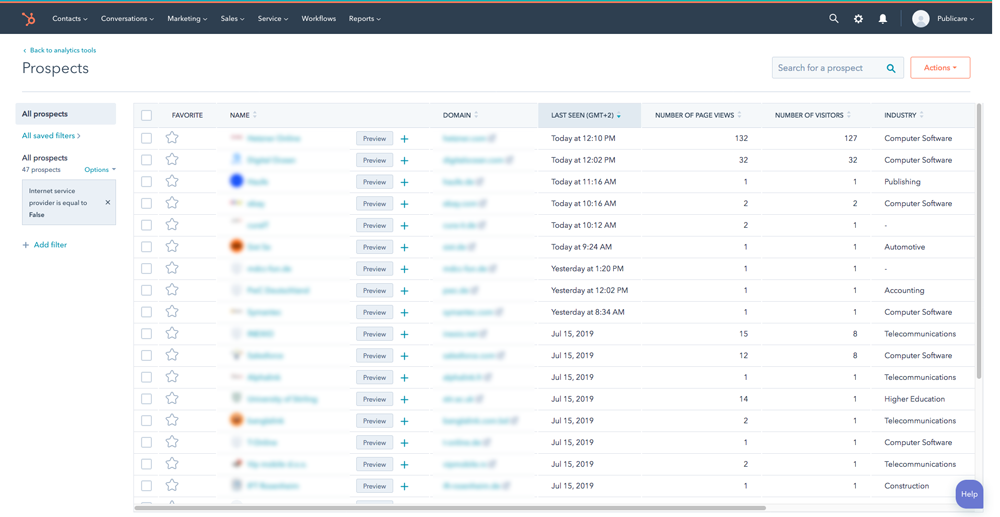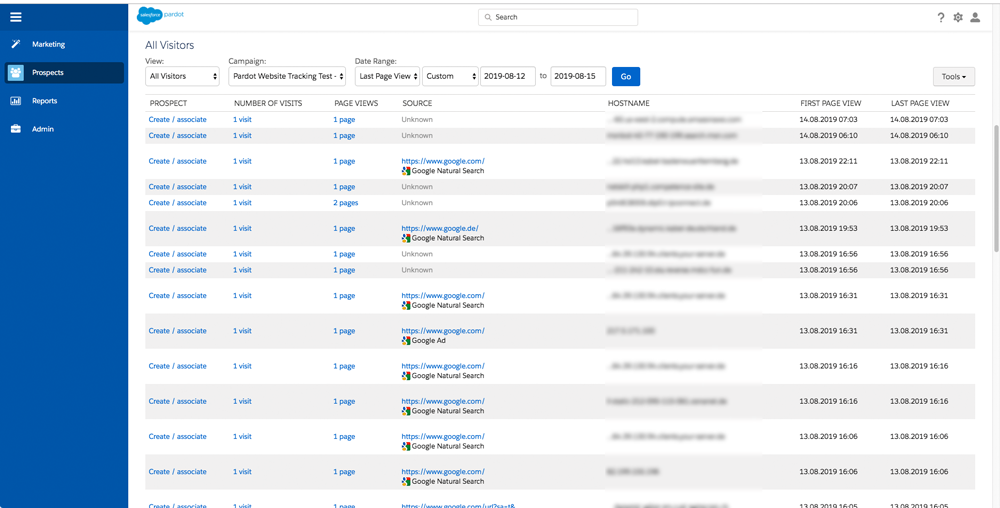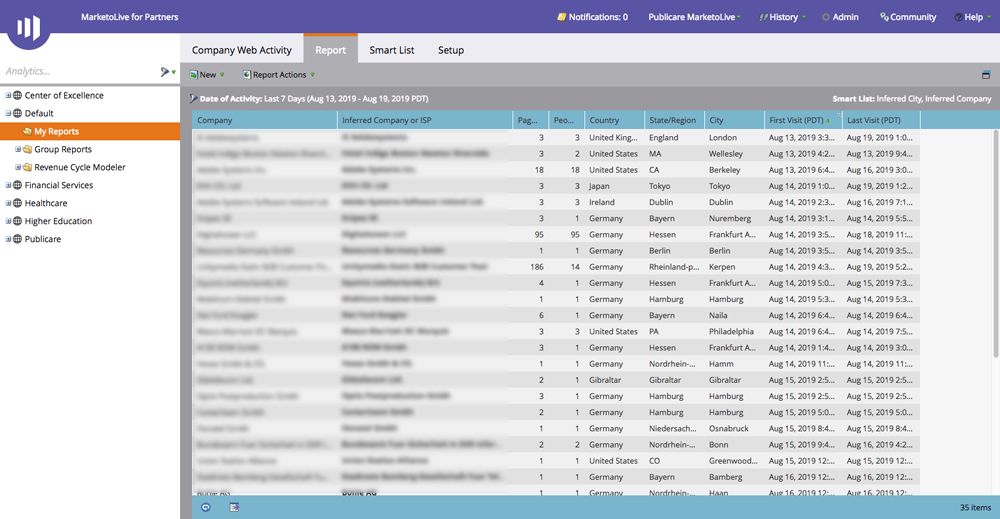
Linking e-mail consent to a prize draw
20. May 2019
Study on Email Marketing in E-Commerce 2019
10. October 2019
B2B Website tracking: Hubspot, Salesforce Pardot, and Adobe Marketo vs. SalesViewer
We tested: How well do B2B marketing automation platforms identify anonymous website visitors with sales potential?
Keeping your eye on the entire user journey: Marketing automation platforms such as Hubspot, Salesforce Pardot and Adobe Marketo promise continuous lead tracking and lead qualification. Among other things, they offer tracking snippets and reports to identify specific companies within the stream of anonymous website visitors. We’ve looked at how well each solution is doing and whether it can stand up to specialized software solutions.
For about a year now, we have been looking closely at the market for B2B tools that offer website visitor identification. The basic idea behind these applications is that instead of just measuring the quantitative traffic on individual pages, page views are bundled based on visitors. And above all, the visitors are identified – of course only companies that are legal entities, not individuals, which would not be permitted under data protection law. As a result, anonymized visitor tracking is practically transformed into a list of potential leads with which marketing and sales can continue to work efficiently.
In our test we conducted a few months ago, we were especially convinced by the providers who were running a complex manual lead identification process in the background. Tools based solely on Google Analytics, on the other hand, performed significantly worse. But what is the point of additional paid software if vendors such as Salesforce, Hubspot, Adobe or Oracle offer integrated solutions with which you can keep an eye on all lead sources? Time for a new test!
Chaff and Wheat
We asked ourselves whether the B2B website visitor tracking technology that is integrated into the popular “big” B2B marketing automation platforms Salesforce Pardot, Hubspot, and Adobe Marketo is workable in practice and delivers similarly good results as the standalone tool SalesViewer, which achieved the best results in our last test. For this purpose, we placed the recognition technology of the above three vendors in direct comparison with SalesViewer in a two-week practical test.
Testing: Hubspot
At the first glance Hubspot already lacks an important element of SalesViewer: There is hardly any information about the origin of a visit. The lead cannot be assigned to any source, such as a Google ads campaign or the original link. This is quite surprising, since complete lead routes are at the center of content or inbound marketing. And while SalesViewer shows exactly how long a certain visitor (or company) has stayed on which page, Hubspot completely lacks this information. What remains is a general list of visitors and the total number of pages they have visited. And even these few details cannot be transferred to the sales department via task assignment – the activity and history of the lead are simply lost.
And what about the actual lead identification – how well does Hubspot recognize anonymous website visitors? In our tests Hubspot only identified about one third of the companies SalesViewer was able to find. Conversely, there is not a single company Hubspot recognized that SalesViewer couldn’t identify. Not only does the Hubspot user completely lose many valuable leads, but the inadequate sorting out of Internet Service Providers (ISPs) also causes unnecessary additional work.
Testing: Salesforce Pardot
Pardot, Salesforce’s B2B marketing automation solution, is the only one of the three solutions we tested that gives users a granular view of each lead. For example, it’s easy to see which pages have been visited and for how long – making it easy for sales to track identified companies. If it weren’t for a special feature: While Hubspot at least allows you to further process the company data record, Pardot does not. A company lead can only be synchronized with the Salesforce CRM solution Sales Cloud if at least one contact is assigned to it. This means that the information gained can only be passed on to the sales department via detours.
The idea (or hope) behind this may be that visitors voluntarily “de-anonymize” themselves e.g. by filling out a form at the end of their User Journey and can then be directly created as a contact. However, this would contradict a basic idea of website visitor recognition, namely to attract the large number of anonymous visitors who are interested and thus relevant to sales, but leave the website without a form request.
Even more problematic is the fact that Salesforce Pardot’s recognition rate is even worse than that of Hubspot: it does not even find one fifth of the companies that SalesViewer can identify. Just like Hubspot, Pardot cannot find a company that is not recognized by SalesViewer. Detailed information does not help if it is limited to a fraction of the relevant visitors.
Testing: Adobe Marketo
Marketo from Adobe tells a similar story to Hubspot’s and cannot hold a candle to SalesViewer in terms of depth of information. Details about individual website visitors are not captured or displayed across all visits, so the actual activity of potential leads cannot really be tracked. But that would be essential for lead qualification: What was the visitor interested in? Which product pages were visited, which videos were viewed, which blog posts were read? A statement such as “3 visitors have visited a total of 4 pages” is of little use.
Somewhat more pleasing: When it comes to the actual lead identification, Marketo delivers the best results of the three major platforms. About two thirds of the SalesViewer hits are also recognized by Marketo and occasionally companies appear that SalesViewer does not know. In any case, the difference in this point is not categorical. However, the poor ISP filtering is annoying: The Internet service providers, which are worthless for winning leads, are only insufficiently sorted out.
What do the test results mean?
Although each of the three large marketing automation solutions has strengths and weaknesses in “internal comparison”, none of the solutions is suitable for a meaningful identification of anonymous website visitors. Their big advantage would be the fact that all leads and activities are integrated in one platform, allowing seamless lead qualification and further processing by marketing and sales. However, none of the three platforms does this adequately.
- Identify website visitors:
No provider solves the core task as well as SalesViewer. If not even half of the hits are detected, this means that more than 50% of the potential leads are lost from the outset. - Recognition quality:
There are many analysis tools that generate vast amounts of information, which are at best “nice-to-have”. However, details about the concrete interest of a visit are indispensable for lead identification because they form the basis for further sales work. Only Salesforce Pardot can compete with SalesViewer. - Handling/Process:
Surprisingly, the B2B platforms tested sometimes put obstacles in the way of sales. The (often little) recorded information cannot be fed completely or only with difficulty into a process – an astonishing lack for solutions with a holistic approach.
Conclusion: The recognition rate and quality are that extra something for B2B website visitor recognition. Currently, the major marketing automation platforms show fundamental shortcomings in this discipline, whereby a large part of the theoretical benefit for sales in particular is lost again in practice. This is all the more regrettable as its classic domain, the acquisition of “opt-in” leads, has been more limited than ever by the Basic Data Protection Ordinance (DSGVO). If these platforms would reliably explore the large field of identification of website-based “non-opt-in” leads, they could open up far more sales potential for their users than lead generation forms ever provide. If you think you can do without specialized solutions such as SalesViewer, WiredMinds Leadlab or Leadforensics when determining website leads, you are saving on the wrong end.




